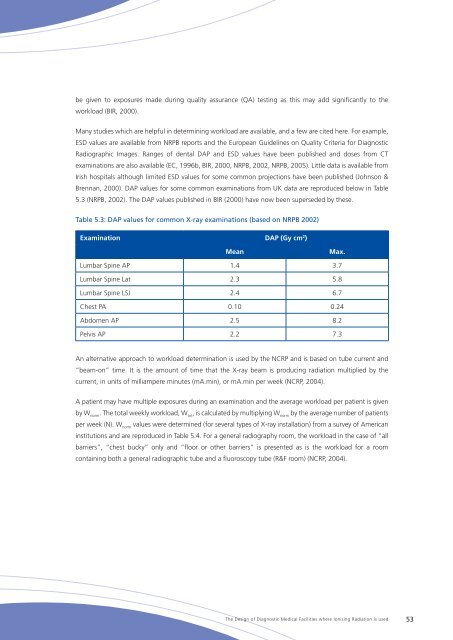The Design of Diagnostic Medical Facilities where ... - ResearchGate
The Design of Diagnostic Medical Facilities where ... - ResearchGate
The Design of Diagnostic Medical Facilities where ... - ResearchGate
Create successful ePaper yourself
Turn your PDF publications into a flip-book with our unique Google optimized e-Paper software.
e given to exposures made during quality assurance (QA) testing as this may add significantly to the<br />
workload (BIR, 2000).<br />
Many studies which are helpful in determining workload are available, and a few are cited here. For example,<br />
ESD values are available from NRPB reports and the European Guidelines on Quality Criteria for <strong>Diagnostic</strong><br />
Radiographic Images. Ranges <strong>of</strong> dental DAP and ESD values have been published and doses from CT<br />
examinations are also available (EC, 1996b, BIR, 2000, NRPB, 2002, NRPB, 2005). Little data is available from<br />
Irish hospitals although limited ESD values for some common projections have been published (Johnson &<br />
Brennan, 2000). DAP values for some common examinations from UK data are reproduced below in Table<br />
5.3 (NRPB, 2002). <strong>The</strong> DAP values published in BIR (2000) have now been superseded by these.<br />
Table 5.3: DAP values for common X‐ray examinations (based on NRPB 2002)<br />
Examination DAP (Gy cm 2 )<br />
Mean<br />
Max.<br />
Lumbar Spine AP 1.4 3.7<br />
Lumbar Spine Lat 2.3 5.8<br />
Lumbar Spine LSJ 2.4 6.7<br />
Chest PA 0.10 0.24<br />
Abdomen AP 2.5 8.2<br />
Pelvis AP 2.2 7.3<br />
An alternative approach to workload determination is used by the NCRP and is based on tube current and<br />
“beam-on” time. It is the amount <strong>of</strong> time that the X‐ray beam is producing radiation multiplied by the<br />
current, in units <strong>of</strong> milliampere minutes (mA.min), or mA.min per week (NCRP, 2004).<br />
A patient may have multiple exposures during an examination and the average workload per patient is given<br />
by W norm<br />
. <strong>The</strong> total weekly workload, W tot<br />
, is calculated by multiplying W norm<br />
by the average number <strong>of</strong> patients<br />
per week (N). W norm<br />
values were determined (for several types <strong>of</strong> X‐ray installation) from a survey <strong>of</strong> American<br />
institutions and are reproduced in Table 5.4. For a general radiography room, the workload in the case <strong>of</strong> “all<br />
barriers”, “chest bucky” only and “floor or other barriers” is presented as is the workload for a room<br />
containing both a general radiographic tube and a fluoroscopy tube (R&F room) (NCRP, 2004).<br />
<strong>The</strong> <strong>Design</strong> <strong>of</strong> <strong>Diagnostic</strong> <strong>Medical</strong> <strong>Facilities</strong> <strong>where</strong> Ionising Radiation is used 53
















